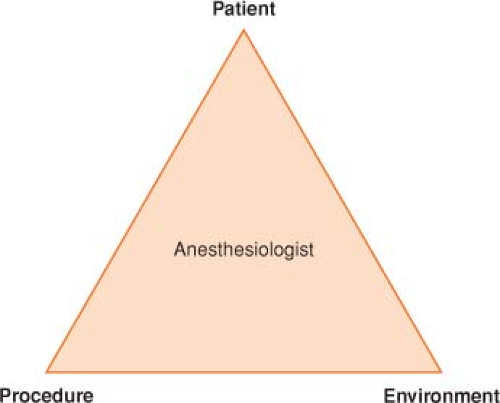Nonoperating Room Anesthesia (Nora)
Nonoperating room anesthesia (NORA) refers to anesthesia that is provided at locations remote from the familiar territory of the traditional operating room (radiology departments, endoscopy suites, magnetic resonance image [MRI] scanners or dental clinics) (Souter KJ, Pittaway AJ. In: Barash PG, Cullen BF, Stoelting RK, Cahalan MK, Ortega R, Stock MC, eds. Clinical Anesthesia. Philadelphia: Lippincott Williams & Wilkins; 2013:876–890). Nonoperating room (NOR) cases account for a significant proportion of the procedural work of hospitals.
I. The Three-Step Approach to Nora (Fig. 32-1)
The Patient. Patients (especially children) may require sedation or anesthesia to tolerate NOR procedures for a number of reasons (Table 32-1).
The Procedure (Table 32-2)
The Environment. The American Society of Anesthesiologists has developed standards for NOR anesthesia (Table 32-3).
Table 32-1 Patient Factors Requiring Sedation or Anesthesia for Nonoperating Room Procedures | ||
|---|---|---|
|
Table 32-2 Common Nonoperating Room Anesthesia Procedures | ||||||||||||||||
|---|---|---|---|---|---|---|---|---|---|---|---|---|---|---|---|---|
|
Table 32-3 ASA Standards for Nonoperating Room Anesthetizing Locations | ||
|---|---|---|
|
II. Patient Safety in Nora
Adverse Events. Respiratory depression secondary to oversedation is the most common type of adverse event in the closed claims study. Capnography provides an earlier monitor of impending respiratory depression during sedation.
Preprocedural checklists (broadly embraced in operating rooms) should be adopted in NOR sites.
Standards of Care for NORA. Guidelines and standards of care for pre- and postanesthesia care, basic monitoring standards, and MAC apply to patients being cared for in all NOR sites in the same way as they do in the operating rooms. The recovery area should be equipped to the same standards as for postoperative patients.
Patient Transfer. Sick, unstable patients may be transferred back and forth between the intensive care unit, the
operating rooms, and NOR locations for imaging or diagnostic procedures. These patients are often mechanically ventilated and receiving a number of drug infusions for both sedation and hemodynamic support. It is also useful to send personnel ahead to secure the elevators to prevent delays during transfer.
III. Sedation and Anesthesia
Definition of Sedation and Anesthesia. Many NOR procedures are performed under “sedation’ or “monitored anesthesia care” (MAC). The Centers for Medicare and Medicaid Services defines Anesthesia as “the administration of a medication to produce a blunting or loss of, pain perception
(analgesia); voluntary and involuntary movements; autonomic function; and memory and/or consciousness.”
The Continuum of Anesthesia. Anesthesia exists along a continuum and the transition from minimal sedation to general anesthesia is not clear cut (Table 32-4).
Table 32-4 Definition of General Anesthesia and Levels of Sedation/Analgesia | |||||||||||||||||||||||||
|---|---|---|---|---|---|---|---|---|---|---|---|---|---|---|---|---|---|---|---|---|---|---|---|---|---|
|
IV. Environmental Considerations for Nora
Radiography and Fluoroscopy. Fluoroscopy is used to obtain real-time moving images of the internal structures that are widely used in many NOR locations (interventional radiology, cardiac catheterization, electrophysiologic procedures, gastroenterology suite).
Hazards of Ionizing Radiation
Stay updated, free articles. Join our Telegram channel

Full access? Get Clinical Tree









